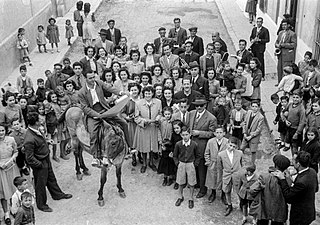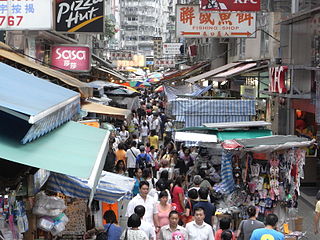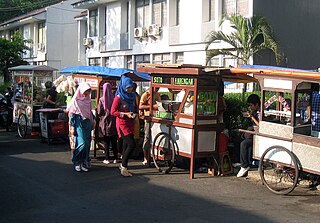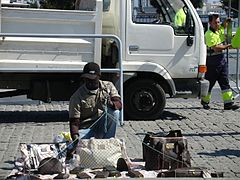
A costermonger, coster, or costard is a street seller of fruit and vegetables in British towns. The term is derived from the words costard and monger (seller), and later came to be used to describe hawkers in general. Some historians have pointed out that a hierarchy existed within the costermonger class and that while costermongers sold from a handcart or animal-drawn cart, mere hawkers carried their wares in a basket.

A huckster is anyone who sells something or serves biased interests, using pushy or showy tactics. In historical terms, it meant any type of peddler or vendor, but over time it has assumed pejorative connotations.

Palika Bazaar, is an underground market located between the inner and outer circle of Connaught Place, Delhi, India. It is named after Palika Bazaar of Mumbai. Palika Bazaar hosts 380 numbered shops selling a diverse range of items; however, the market is dominated by electronic items and clothing. Palika Bazaar was set up in the late 1970s, but since the 1980s it has seen a decline in customers, in part due to the opening of several new, modern shopping malls all over Delhi.

A peddler, in British English pedlar, also known as a chapman, packman, cheapjack, hawker, higler, huckster, (coster)monger, colporteur or solicitor, is a travelling vendor of goods. In 19th-century America the word "drummer" was often used to refer to a peddler or traveling salesman; as exemplified in the popular play Sam'l of Posen; or, The Commercial Drummer by George H. Jessop.

Sadar Bazaar is the largest wholesale cosmetics jewellery market of household items in Old Delhi, Delhi, India.

Street food refers to food or drinks sold by a hawker or vendor on a street or at other public places, such as markets, fairs, and parks. It is often sold from a portable food booth, food cart, or food truck and is meant for immediate consumption. Some street foods are regional, but many have spread beyond their regions of origin. Most street foods are classified as both finger food and fast food and are typically cheaper than restaurant meals. The types of street food vary between regions and cultures in different countries around the world. According to a 2007 study from the Food and Agriculture Organization, 2.5 billion people eat street food every day. While some cultures consider it to be rude to walk on the street while eating, a majority of middle- to high-income consumers rely on the quick access and cheap service of street food for daily nutrition and job opportunities, especially in developing countries.

Taiwanese night markets are night markets in Taiwan that operate in urban or suburban areas between sunset and sunrise. A few, such as Huaxi Street Tourist Night Market, use purpose-built marketplaces, but most occupy either sidewalks or even entire streets that carry vehicle and pedestrian traffic by day. Some night markets in smaller side streets and alleys feature retractable roofs. Most night markets operate daily and feature a mixture of individual stalls selling clothing, consumer goods, xiaochi, and specialty drinks. The atmosphere is usually crowded and noisy with hawkers shouting and fast-paced music playing over loudspeakers. Taiwanese night markets have evolved over the years from small, local gatherings to noisy streets lined with vendors, who must adhere to regulations placed on their activities by the Taiwanese government.

Law Garden, officially Sheth Motilal Hirabhai Park, is an urban park in Ahmedabad, Gujarat, India. It was redeveloped in 1997. There is a street market of handicraft goods, street food and other goods along the walls of the garden. The street market was revamped in 2020.

A tianguis is an open-air market or bazaar that is traditionally held on certain market days in a town or city neighborhood in Mexico and Central America. This bazaar tradition has its roots well into the pre-Hispanic period and continues in many cases essentially unchanged into the present day. The word tianguis comes from tiyānquiztli or tianquiztli in Classical Nahuatl, the language of the Aztec Empire. In rural areas, many traditional types of merchandise are still sold, such as agriculture supplies and products as well as modern, mass-produced goods. In the cities, mass-produced goods are mostly sold, but the organization of tianguis events is mostly the same. There are also specialty tianguis events for holidays such as Christmas as well as for particular types of items such as cars or art.

An arabber is a street vendor (hawker) selling fruits and vegetables from a colorful, horse-drawn cart. Once a common sight in American East Coast cities, only a handful of arabbers still walk the streets of Baltimore. They rely on street cries to attract the attention of their customers.

Street cries are the short lyrical calls of merchants hawking their products and services in open-air markets. The custom of hawking led many vendors to create custom melodic phrases to attract attention. At a time when a large proportion of the population were illiterate, the cries of street vendors and town criers provided the public with important messages, whether those messages were commercial in nature or of more general public interest. Street Cries were part of the aural fabric of street life from antiquity.

Pregón, a Spanish word meaning announcement or street-seller's cry, has a particular meaning in both Cuban music and Latin American music in general. It can be translated as a song based on a street-seller's cry or a street-seller's song.

Street Vendors Act, 2014 is an Act of the Parliament of India enacted to regulate street vendors in public areas and protect their rights. It was introduced in the Lok Sabha on 6 September 2012 by then Union Minister of Housing and Urban Poverty Alleviation, Kumari Selja. The Bill was passed in the Lok Sabha on 6 September 2013 and by the Rajya Sabha on 19 February 2014. The bill received the assent of the President of India on 4 March 2014. The Act came into force from 1 May 2014.

The presence of street vendors in Mexico City dates back to pre-Hispanic era and over the centuries the government has struggled to control it, with most recently a clearing of downtown streets of vendors in 2007, but despite this there is a persistent presence of many thousands illegally. Even after oscillating between the realms of legality and illegality, street vending in Mexico and even in other parts of the world, is not the exception but rather has been a norm when it comes to commercial activities. In 2003, it was estimated that there were 199,328 street vendors in Mexico City.

Hawkers in Hong Kong are vendors of street food and inexpensive goods. They are found in urban areas and new towns alike, although certain districts such as Mong Kok, Sham Shui Po, and Kwun Tong are known for high concentrations of hawkers.

Indonesian street food is a collection of ready-to-eat meals, snacks, fruits and drinks sold by hawkers or vendors at warung food stalls or food carts. Street food in Indonesia is a diverse mix of local Indonesian, Chinese, and Dutch influences. Indonesian street food are usually cheap, offer a great variety of food of different tastes, and can be found on every corner of the city.

Street food in Thailand brings together various offerings of ready-to-eat meals, snacks, fruits and drinks sold by hawkers or vendors at food stalls or food carts on the street side in Thailand. Sampling Thai street food is a popular activity for visitors, as it offers a taste of Thai cooking traditions. Bangkok is often mentioned as one of the best places for street food. In 2012, VirtualTourist named Bangkok as the number one spot for street food—the city is notable for both its variety of offerings and the abundance of street hawkers.
The retail format influences the consumer's store choice and addresses the consumer's expectations. At its most basic level, a retail format is a simple marketplace, that is; a location where goods and services are exchanged. In some parts of the world, the retail sector is still dominated by small family-run stores, but large retail chains are increasingly dominating the sector, because they can exert considerable buying power and pass on the savings in the form of lower prices. Many of these large retail chains also produce their own private labels which compete alongside manufacturer brands. Considerable consolidation of retail stores has changed the retail landscape, transferring power away from wholesalers and into the hands of the large retail chains.
The Safe Sidewalk Vending Act is a 2018 California law decriminalizing street vending and legalizing street vending under certain conditions.
The Sindicato Popular de Vendedores Ambulantes is a workers union representing street vendors in Spain. The vendors often face precarious economic conditions, lack of access to government services, racist discrimination, and violence from the hands of police.

































